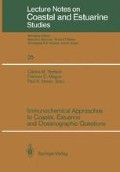Abstract
Immunofluorescent staining techniques for detecting cell surface antigens have evolved over the past forty-five years (Coons et al., 1941) to the point where it is now possible to detect up to five cell surface antigens simultaneously (Horan et al., 1986). To a great degree, this precision has been dependent upon advances in three areas. First, instruments such as flow cytometers were created that could analyze cellular immunofluorescence with much greater speed and precision than analysis utilizing fluorescence microscopes. Second, the introduction of monoclonal antibodies as probes to detect cellular antigens provided remarkable specificity and uniformity. Finally, chemical modifications of fluorochrome molecules facilitated simple conjugation and purification procedures as well as produced fluorochromes which exhibited distinct spectral emission characteristics.
Access this chapter
Tax calculation will be finalised at checkout
Purchases are for personal use only
Preview
Unable to display preview. Download preview PDF.
References
Bayer, E.A. and M. Wilcheck. 1978. The avidin-biotin complex as a tool in molecular biology. TIBS. 3: N257.
Blue, M.L., J.F. Daley, H. Levine and S.F. Schlossman. 1986. Discrete stages of human thymocyte activation and maturation in vitro: correlation between phenotype and function. Eur. J. Immunol. 16: 771–777.
Buckland, R.M. 1986. Strong signals from streptavidin-biotin. Nature. 320: 557.
Carlsson, J., H. Drevin and R. Axen. 1978. Protein thiolation and reversible protein-protein conjugation: N-succinimydyl 3 (2-pyridyldithio) propionate, a new heterobifunctional reagent. Biochem. J. 173: 723–737.
Coons, H.A., J.H. Creech and N.R. Jones. 1941. Immunological properties of an antibody containing a fluorescent group. Proc. Soc. Exptl. Biol. Med. 47: 200.
Glazer, N.A. and L. Stryer. 1984. Phycofluor probes. TIBS. 9: 483.
Hercend, T., J. Griffin, A. Bensussan, R. Schmidt, M.A. Edson, A. Brennan, C. Murray, J.F. Daley, S.F. Schlossman and J. Ritz. 1985. Generation of monoclonal antibodies to a human natural killer clone. J. Clin. Invest. 75: 932.
Hofmann, K., G. Titus, J.A., Montibeller and F.A. Finn. 1982. Avidin binding of carboxyl substituted biotin andanalyogues. Biochem. 21: 978–984.
Horan, P.K., S.E. Slezak and G. Poste. 1986. Improved flow cytometric analysis of leukocyte subsets: simultaneous identification of five cell subsets using two color immunofluorescence. Proc. Natl. Acad. Sci. 83: 8361–8365.
Lanier, L.L. and M.R. Loken. 1984. Human lymphocyte subpopulations identified by using three color immunofluorescence and flow cytometry analysis. J. Immunol. 132: 151.
Oi, V., A.N. Glaser and L. Stryer. 1982. Fluorescent phycobiliprotein conjugates for analysis of cells and molecules. J. Cell Biol. 93: 981–986.
Rothbarth, Ph.H., H.J. Tanke, N.A.J. Mul, J.S. Ploem, J.F.C. Uliegenthart and R.E. Ballieux. 1978. Immunofluorescence studies with 4-acetamido-4’-isothiocyanato stilbene-2,2’ disulfonic acid (SITS). J. Immunol. Methods. 19: 101.
Titus, A.J., R.P. Haugland, S.O. Sharrow and M.D. Segal. 1982. Texas Red, a hydrophillic, red-emitting fluorophore for use with fluorescein in dual parameter: Flow microfluorometric and fluorescence microscopic studies. J. Immunol. Methods. 50: 193.
Weir, M.D. (editor) 1978. Handbook of Experimental Immunology. 1:Chapter 7.
Wysocki, L.J. and V.L. Sato. 1978. Panning for lymphocytes: a method for cell selection. Proc. Natl. Acad. Sci. 75: 284.
Author information
Authors and Affiliations
Editor information
Editors and Affiliations
Rights and permissions
Copyright information
© 1988 Springer-Verlag New York, Inc.
About this paper
Cite this paper
Daley, J.F. (1988). Immunofluorescent Reagents: Preparation and Analysis. In: Yentsch, C.M., Mague, F.C., Horan, P.K. (eds) Immunochemical Approaches to Coastal, Estuarine and Oceanographic Questions. Lecture Notes on Coastal and Estuarine Studies, vol 25. Springer, New York, NY. https://doi.org/10.1007/978-1-4684-7642-2_12
Download citation
DOI: https://doi.org/10.1007/978-1-4684-7642-2_12
Publisher Name: Springer, New York, NY
Print ISBN: 978-0-387-96894-0
Online ISBN: 978-1-4684-7642-2
eBook Packages: Springer Book Archive

